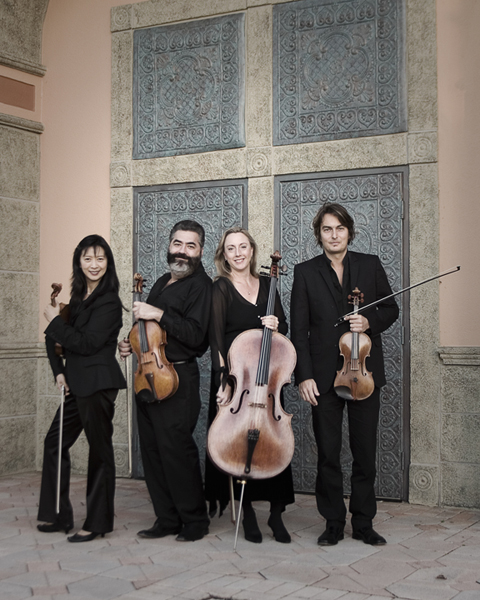Delray Quartet provides intense advocacy for Sleeper premiere
 It has been a couple months of milestones for the Delray String Quartet, which released its first commercial disc, an all-Dvorak program, in December.
It has been a couple months of milestones for the Delray String Quartet, which released its first commercial disc, an all-Dvorak program, in December.
On Sunday afternoon at the Colony Hotel in Delray Beach, the five-year-old foursome presented two debuts: their new cellist, whom they expect to be the permanent occupant of that chair, and the world premiere of an exciting new piece written especially for them.
 That piece, the String Quartet No. 3 of Thomas Sleeper, the University of Miami-based educator and composer, is in every way an important and impressive contribution to the genre of American string-quartet writing. In its three movements and roughly 25 minutes, it offers an emotional range from agitated to playful to anguished, and a harmonic language that varies from the resolutely tonal to the severe and uncompromising.
That piece, the String Quartet No. 3 of Thomas Sleeper, the University of Miami-based educator and composer, is in every way an important and impressive contribution to the genre of American string-quartet writing. In its three movements and roughly 25 minutes, it offers an emotional range from agitated to playful to anguished, and a harmonic language that varies from the resolutely tonal to the severe and uncompromising.
In its overall darkness, intensity and seriousness of intent, it perhaps evokes most closely the quartets of Shostakovich, particularly in the second movement, with a nod or two throughout to the motivic and tonal asperities of Bartok. Technically, it is quite a difficult quartet, with a sonic texture that demands each of the four players be able to confidently dip into a picnic basket brimming with virtuosic challenges.
And the Delrays were largely successful as advocates. The group’s best moments came in the midsection of the second movement, a slow, heartbroken waltz that slips in and out of B minor and rises from a bare fifth in the viola and cello to a huge climax in which the first violin plays sighing, striving sixths over a closely voiced accompaniment in which the other instruments are playing in their higher registers. This music makes a dramatic return in the finale, neatly unifying the piece.
There were good ensemble moments as well in the opening bars of the first movement, as first violinist Mei Mei Luo and cellist Susan Moyer Bergeron played the germinal motif of the quartet, a rising melody that basically encompasses a simple chromatic scale, with just the right tone to point the path for the journey to come. And there was attractive playing in the tricky opening of the finale, a murmuring in the second violin (Laszlo Pap) and viola (Richard Fleischman) that opens up into fast time changes, punctuated offbeats and colorful pizzicato glimmers before settling on repeated hammering chords that come to dominate the movement.
Problems also were evident, especially in some ensemble shakiness in the closing bars of the opening movement (marked Prestissimo) and in the finale’s return of the slow music from the second, in which the Delrays didn’t so much ease into the new tempo as slam on the brakes. But these are minor faults, and overall the Delray String Quartet can be proud of its new role as champion of contemporary music.
One looks forward not only to the upcoming recording the group plans to do of the Sleeper Third Quartet, but to the adoption of this fine piece by enterprising string quartets everywhere.
The second half of the concert contained the Clarinet Quintet of Brahms, with guest soloist Paul Green. A familiar face to Palm Beach concertgoers who have seen him in everything from concerti to klezmer, Green plays with a mature, rounded, full tone that is ideal for the melancholy sweetness of this late Brahms work. Aside from a noticeable flub at the high end of an all-register swoop in the second movement, he played with conspicuous loveliness, especially as he introduced the theme of that same movement.
Although Green’s sound blended well with the Delray Quartet, which tends to a Romantic approach in general, there were some ensemble miscues; it took three tries for the five musicians to get together on the dramatic three-note motto that announces the second theme of the first movement. There was also a noticeable lack of contrast as the work progressed, which is partly the fault of Brahms, but there are ways to make the individual movements more distinctive: a slightly speedier tempo for the third movement, for instance.
Still, it was easy to fall under the spell of the smooth peacefulness of this performance, which was followed by an encore, the third-movement Minuet of the Mozart Clarinet Quintet. The Sleeper was dramatic, the Brahms wistful, but the Mozart was the embodiment of geniality, and it made for an effective end to a concert that marked a real advance for this ensemble.
The Delray String Quartet’s next concert is 4 p.m. Sunday, March 8, at the Colony Hotel in Delray Beach. On the program are the Haydn Quartet in D minor, Op. 76, No. 2 (Fifths), and the Sring Quartet in G minor of Edvard Grieg. Tickets are $35 and can be had by calling 561-213-4138.
Greg Stepanich has covered classical music, theater and dance for 25 years at newspapers in Illinois, West Virginia and Florida. He worked for 10 years at The Palm Beach Post, where he was an assistant business editor and pilot of Classical Musings, a classical music blog. He now blogs for the Palm Beach ArtsPaper at www.pbartspaper.com, and writes a personal blog at classicalgreg.wordpress.com. He also works as a freelance writer and composer.
Posted in Performances
Leave a Comment
Mon Feb 2, 2009
at 12:52 pm
No Comments






